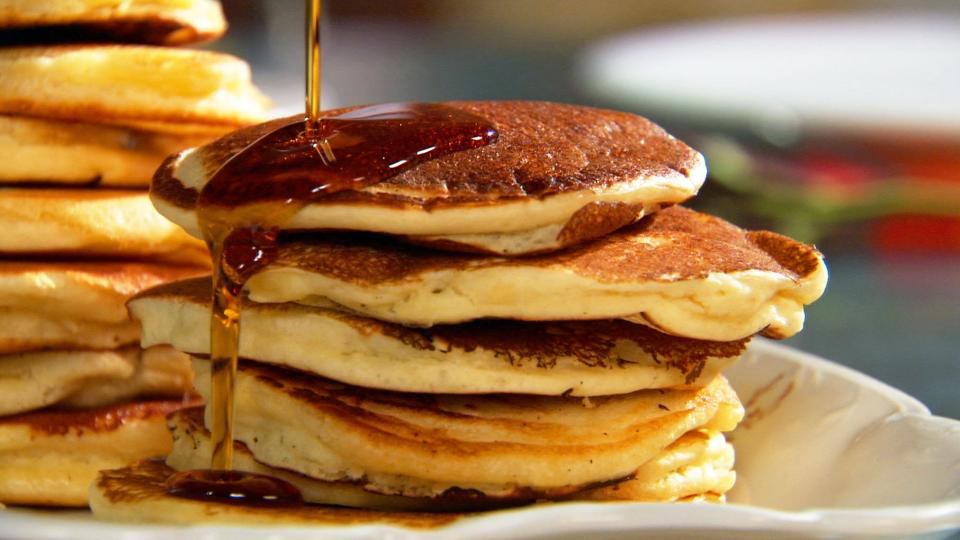Why Do We Eat Pancakes with Maple Syrup?
The perfect weekend breakfast, without a doubt, is a stack of pancakes, hot off the griddle, topped with pure maple syrup. Yum. It's a combination as elemental as peanut butter and jelly, originating at least two hundred years ago, if not more. Pancakes and maple syrup each have their own lore, but as to how they came together? Well, that's not so straightforward.
Related: Get Our Pancake Recipes

Pancakes Through the Ages
Pancakes are literally as old as the hills, reaching back to our prehistoric ancestors who made their own sort of pancake either with ground grains and nuts or ground plants like ferns, cooking them on hot stones. The ancient Greeks and Romans whipped up pancakes with wheat flour, olive oil, honey, and milk. In medieval times pancakes were made with buckwheat or rye, sans leavening, while the Elizabethans favored flavorings of rose water, sherry, apples, and spices. Shakespeare, no doubt smitten, mentioned pancakes in two of his plays, All's Well That Ends Well and As You Like It. And every culture seems to have its variation on pancakes, from French crêpes, Russian blini, and Swedish pancakes, to Welsh crampog, Dutch pannekoek (also spelled pannekoeken), and Native American Indian cakes or johnnycakes, which were made from cornmeal.
Dutch colonists brought their pannekoek recipes to America and by 1740 they were dubbed buckwheat cakes, while the English brought Shrove Tuesday, or Pancake Tuesday, a traditional feast day falling before the start of Lent. Pancakes stacked up as a great American breakfast for Thomas Jefferson and Benjamin Franklin, who adored hoecakes. And pancakes, also known as griddle cakes, hotcakes, and flapjacks, among other names, even figured into the legend of Paul Bunyan, the American folklore hero and mighty lumberjack with a giant appetite to match.
An Indigenous Discovery Shared with Colonists
Maple sugar also played a role in Native American mythology. Indigenous communities of northeastern North America were the first to discover the magic of maple. They tapped sugar maple trees and turned the sap into maple sugar, using a process called sugaring, which they taught to the Europeans. In Canada, there are accounts from as early as the mid-1500s of French settlers learning maple sugaring techniques from indigenous tribes, boiling the sap into syrup or bricks for future consumption. And it may have been the early pioneers who used syrup as a stand-in for more familiar toppings like treacle or syrup, typically made from cane sugar.
"I think that maple as a flavoring of rather bland things such as hoecakes, our traditional Iroquois cornbread, johnnycakes and later on Dutch pannekoek, French crêpes and English/Scots Canadian scone or bannock, and eventually American-style pancakes, all make sense," says Dave Smoke McCluskey, a Mohawk chef with strong roots in New York and New England, who also owns the small-batch hominy and masa company, Corn Mafia and Lyeing Mohawk Masa. The Dutch pannekoek, he points out, were often served with stroop, a thick apple syrup, similar to colonial boiled cider. And the Mohawk and Dutch trade endured for decades—close enough that a pidgin of Dutch and Mohawk was spoken—and perhaps another union, of a culinary stripe, formed. "My guess is that enjoying pancakes with maple syrup sprang from this strong friendship. It makes the most sense to me," he says.
Historians of Old Sturbridge Village in Sturbridge, Massachusetts, a living museum that celebrates New England's early colonists in the formative period of 1790 to 1840, point to other possibilities. "The first reference we know of people putting maple anything on their pancakes, or fritters, is from The Housekeeper's Assistant from 1845 and published in Boston," they say. And a recipe (then referred to as a "receipt") for maple molasses, they add, can be found earlier in Susannah Carter's cookbook, The Frugal Housewife, from 1803. "Though initially an English publication, this was an edition published in New York with the addition of 'several new receipts adapted to the American mode of cooking.'"
We Still Flip for Flapjacks
There were other reasons why maple syrup found its way to the plate. "Maple syrup in this region is what people use as a sweetener because granulated sugar coming up from Cuba and Haiti in the past century was much more expensive," explains Laura Glenn, who, along with her husband Eric Sorkin, co-owns the Vermont-based Runamok Maple, which sells pure, infused, smoked, and barrel-aged maple syrup. Curiously, the light maple syrup back then was called fancy, and emulated sugar as much as possible, she says, while Grade B syrup, with its robust flavor, was exported—a stark reversal of history compared to today's tastes.
However pancakes and maple syrup joined forces, one thing's for sure: It's a storied combination with staying power. The reasons why it tastes so darned good are probably as infinite as the stories associated with each foodstuff's beginnings. Whatever your pancake preference—plain and simple, or with blueberries, oats, or bananas and buttermilk—just stack them up and let the maple pour.

